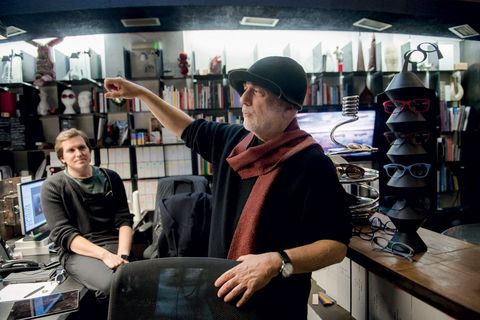Sectors & markets
An evening with: Ron Arad

A tour of the artist’s atelier revealed surprising insights into to his process and the art of being creative
It’s important to create expectations, and then to break them.'
This is one way that the architect and designer Ron Arad describes his creative process. The Royal Academician is widely celebrated for his inventive and playful creations, like the bookworm bookshelf and the rover chair.
The latest meeting of the Luxury Club attended an exclusive tour of Arad’s Chalk Farm studio, and a presentation of his work at the Roundhouse, where members enjoyed champagne courtesy of Ruinart and a mustard tasting. The session was overseen by the club chair Tom Meggle, Managing Director of Louis Vuitton UK, Ireland can South Africa.
Speaking about one of his quixotic chairs, this one constructed out of bent sheet metal and held in place with bolts, Arad commented that often the heart of the design process is a meeting of wills: ‘The will of the designer plus the will of the material.’
The tour included other fascinating materials, such as a 3D printed book in the mould of Albert Einstein’s face – the book was created as part of an Einstein legacy project, celebrating 100 years since his theory of relativity. The walls were adorned with bookshelves that curlicued as if taken from the pages of Dr Suess.
Arad’s busy studio, which includes offices for his parallel practices in design, fine art and architecture, was also filled with delightful rocking chairs in the shapes of tear drops and tree stumps, blue prints for buildings going up around the world and a wide assortment of objects that defy simple categorisation as a product of ‘design’ or of ‘art’.
This question is of course not lost on the artist himself, who when reflecting on his prestigious appointment to the Royal Academy in 2012, wondered which aspect of his work was being honoured.
His best known building, for example, is the now iconic design museum in Tel Aviv, characterised by its shape of undulating chromatic red ribbons.
‘Architecture is normally a journey of compromises,’ said Arad. ‘There’s the budget, and pleasing the neighbours, and working with all kinds of people. For the design museum, I honestly didn’t believe they were going to built it, so I did what I wanted.’
Later at a presentation of his work at the Roundhouse, Arad explained that his design of the museum defied conventions in more ways than one – it also holds the distinction of being the only public building in Isreal without a mezuzah (the small scroll affixed to the doorway or threshold of a building). ‘There is no threshold in the building – you flow in and out,’ said Arad.
« Arad's busy studio was filled with rocking chairs in the shape of tear drops a, blue prints for buildings going up around the world, and a wide assortment of objects that defy categorisation. »
But what may sum up the artist best is his love of ping pong. Among his many ongoing projects is a series of ping pong tables, built to be both functional – he really does play on them – and aesthetically beautiful. And in an Arad twist he has slightly canted the surface to slow the ball down and make the game easier to play. Art meets design meets functionality.
This article was originally published in INFO magazine, January/February 2018